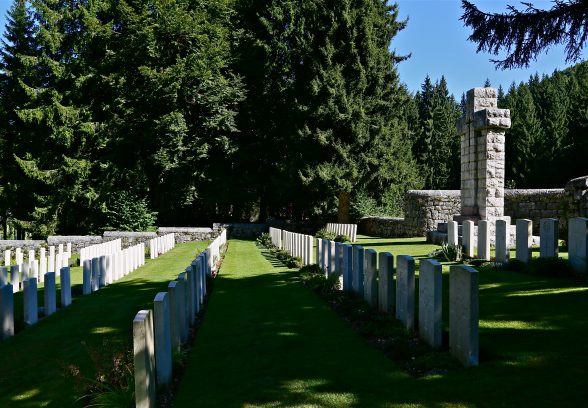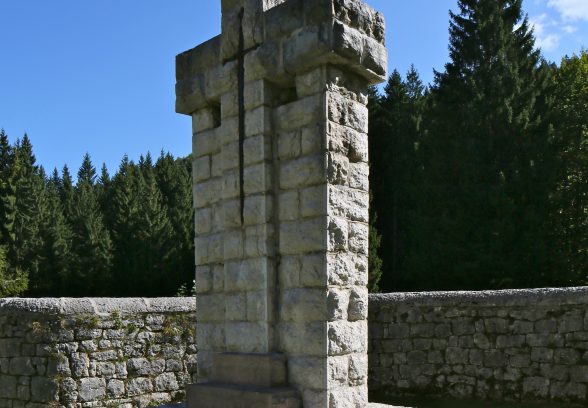This website uses cookies
This website uses cookies to enable it to function properly and to analyse how the website is used. Please click 'Close' to accept and continue using the website.





Italy: Magnaboschi British War Cemetery
Architect: Sir Robert Lorimer
Owners: Commonwealth War Graves Commission
Location: Vicenza, Italy
This is one of five British cemeteries on the Asiago plateau designed by Sir Robert Lorimer (the others are at Barenthal, Boscon, Cavaletto and Granezza). The cemetery contains 180 burials. The dead could all have been moved to one larger cemetery, but the policy adopted on the Western Front, of keeping small war cemeteries, was followed here, although it led to practical difficulties. These five British war cemeteries are different from the Western Front examples; they are surrounded by rough walling of local stone, with curved corners, and Lorimer designed his own rugged version of the Cross of Sacrifice in response to local conditions and the severe winter weather. To quote Philip Longworth in The Unending Vigil (1967), “Such places were already beautiful and Lorimer was content to treat them simply. But there were problems even in such idyllic spots. The Asiago cemeteries were threatened by wandering mountain cattle, and strong rubble walls had to be built to keep them out. The local labourers demanded extra pay for working at such high altitudes, and the steep and tortuous roads prevented the transportation of the [Great War] Stone and the Cross [of Sacrifice]. Everywhere climate and soil structure forced departures from the horticultural standards of the Western Front… so carpeting plants were used instead. Advantage was taken of the tall Italian cypress, but visitors were to be reminded of the peculiarly English nature of these cemeteries by the dwarf roses which were nurtured in them. The craftsmen and materials were excellent, if expensive. Vicenza marble was giving the Italian cemeteries a greater claim to permanence than almost any others.”
Robert Lorimer (1864-1929) was appointed Principal Architect for Italy, Macedonia and Egypt for the Imperial War Graves Commission in September 1918 and was responsible for twelve cemeteries in North Italy. The distinguished Scottish Arts & Crafts architect and designer, whose best-known work is the Scottish National War Memorial in Edinburgh Castle, was probably recommended to the IWGC by his friend Lutyens. He received a letter about his possible appointment from Sir Frederick Kenyon followed almost immediately by a telegram summoning him to a meeting in London where terms were agreed. His instructions included ensuring the designs were kept simple and inexpensive with Kenyon stating “The country needs dignity and refined taste, not ostentation, and then it will not grudge the cost”. Lorimer left for Italy a week later and spent a fortnight inspecting sites, including the Asiago plateau; he recorded that he visited “a number of pathetic little cemeteries with their rows of wooden crosses. This was right up close to the front line and shell fire even going over our heads at one place. They made us wear tin hats.” Most of the Italian cemeteries were complete by 1921; Lorimer visited them for a third time in 1923 when King George V and Queen Mary opened the Italian cemeteries officially. Sir Fabian Ware, founder and vice-chairman of the IWGC, described them “as impressive and artistically perfect as anything in the world”. Opposite the British cemetery at Magnaboschi is the Italian Cemetery with Austro-Hungarian graves. Under an agreement of the late 1960s, the remains here were re-interred in the Sacrario at Asiago, but it was decided to retain five of the eight Austro-Hungarian war cemeteries in the area as memorials, with the gravestones (tree trunks) left in situ.
Gavin Stamp
Commonwealth War Graves Commission
Either enter the name of a place or memorial or choose from the drop down list. The list groups memorials in London and then by country

Become a C20 member today and help save our modern design heritage.